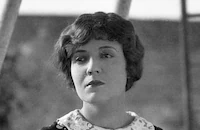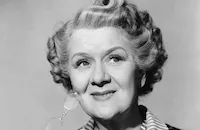Female

Brief Synopsis
Cast & Crew
Michael Curtiz
Ruth Chatterton
George Brent
Lois Wilson
Johnny Mack Brown
Ruth Donnelly
Film Details
Technical Specs

Synopsis
Alison Drake, the president of a large automobile company, is cynical about love and casually seduces the attractive men in her company, but her meaningless affairs only add to her boredom and confirm her belief that men, like women, can be bought with money and power. One night, in search of excitement, Alison goes to a shooting gallery and meets Jim Thorne, who declines her sexual advances. The next day, when Jim shows up at her office, Alison learns that he is the renown engineer she is expecting. She coolly discusses business with him and then invites him to her home. Expecting another conquest, Alison is surprised when Jim rebuffs her again. Determined to break him, Alison successsfully gets Jim alone on a country picnic, and this time, he succumbs to her charms. When he asks her to marry him, though, it is she who turns him down. Furious, he quits his job with her and leaves town. Alison, realizing that she is truly in love, follows him, but misses a very critical business meeting. When she finally catches up with Jim, she tearfully admits that she was willing to risk bankruptcy to find him. This time, he willingly accepts her.

Director

Michael Curtiz
Cast

Ruth Chatterton

George Brent

Lois Wilson

Johnny Mack Brown

Ruth Donnelly
Ferdinand Gottschalk

Phillip Reed

Gavin Gordon
Kenneth Thompson
Huey White

Douglas Dumbrille
Spencer Charters

Walter Walker
Charles Wilson
Edward Cooper

Rafaela Ottiano

Jean Muir

Laura Hope Crews
Crew
M. A. Anderson
G. W. Bernsten
Tom Brannigan
I. A. Brown
Charles Ferguson
Leo F. Forbstein
Sid Hickox
Jack Killifer
Charles Lang
Stanley Logan
Gene Markey
L. P. "dudie" Mashmeyer
William Mcnally
Jack Okey
Orry-kelly
Robert Presnell
Bobby Robinson
Kathryn Scola
Charles Scott Welbourne
William Wellman

Photo Collections
Videos
Movie Clip



Trailer
Hosted Intro
Film Details
Technical Specs

Articles
Female
Ruth Chatterton stars as Alison Drake, known to her employees as “Miss D.” Having inherited an automobile factory from her father, she runs it brilliantly. In charge of her secretarial pool, “Pett” Pettigrew (Ferdinand Gottschalk), describes her as “a superwoman. She’s never found a man worthy of her and she never will!”
When it comes to men, she may not buy, but she certainly does a lot of shopping. This was the element of the script that raised a red flag over at the Studio Relations Committee (SRC), the practically toothless enforcers of the Production Code at that time. Mark A. Vieira, in his excellent book Sin in Soft Focus: Pre-Code Hollywood, reprints a letter sent from the head of the SRC to Warner Brothers objecting to the plot of Female:
“...It is made very plain that she has been in the habit of sustaining her freedom from marriage, and at the same time satisfying a too definitely indicated sex hunger, by frequently inviting any young man who may appeal to her to her home and there bringing about a seduction. After having satisfied her desires with these various males, she pays no further attention to them other than to reward them with bonuses. And in the event that they become importunate, she has them transferred...”
Wingate insisted Warner Brothers eliminate this material from the film. Warner Brothers agreed and then, as most studios did at this time, completely ignored his request. The film was released with all its salaciousness intact. After Joseph Breen instituted a Production Code crackdown in mid-1934, Female was placed on his list of films never to be re-released under any circumstances. The film sat untouched in the vaults until the Breen Office ended in the 1950’s.
In addition to seeing a film 70 years old deal with a sexually-strong female character just this side of Sex and the City, Female has a number of interesting background details. The exterior of Miss D’s home and love nest is Frank Lloyd Wright’s Ennis House, located in the Hollywood Hills. Chatterton and the man who plays the one guy who says no without a ring, George Brent, were married at the time this film was made. There was a veritable merry-go-round of directors who worked on this film. William Dieterle began the film with cameraman Sid Hickox. When Dieterle fell ill, the film was taken over and completed by William Wellman using cameraman Ernest Haller. At that point Warner Brothers decided the lead “boy toy,” George Blackwood, was not up to the job. They replaced him with Johnny Mack Brown and brought in Michael Curtiz who ended up re-shooting half the movie and gaining the final directorial credit.
Producer: Robert Presnell, Sr.
Director: Michael Curtiz, William Dieterle, William A. Wellman
Screenplay: Gene Markey, Kathryn Scola
Art Direction: Jack Okey
Cinematography: Sidney Hickox
Editing: Jack Killifer
Music: Leo F. Forbstein
Cast: Ruth Chatterton (Alison Drake), George Brent (Jim Thorne), Philip Faversham (Claybourne), Ruth Donnelly (Miss Frothingham), Johnny Mack Brown (Cooper), Lois Wilson (Harriet), Gavin Gordon (Briggs).
BW-61m.
by Brian Cady

Female
Female - Ruth Chatterton Stars in the Racy Pre-Code Drama FEMALE (1933)
A business dynamo during the day, Alison spends her evenings seducing selected male employees in her palatial home. She goes through clerks and publicity executives like Kleenex, signaling her amorous intentions with a wink and a toss of a pillow onto a plush rug. Her cast-off lovers are paid off with bonuses or transferred to remote offices, like Fred MacMurray's ex-secretaries in The Apartment. One young Adonis is more interested in literature than romance (are we supposed to think him gay?) so Alison packs him off to school in Europe, all expenses paid. Made angry by weaklings and fortune hunters, Alison goes to a carnival shooting gallery to try her hand at a daring direct pick-up.
It's likely that 1933 audiences considered the movie's entire premise a wicked joke. Alison Drake's behavior is a conscious reversal of the droit de seigneur commonly enjoyed by powerful men, daring us to reconsider male and female roles in society. Today's empowered female executives will applaud Alison's independence, at least while it lasts. To preserve the status quo, Alison's undoing arrives in the form of handsome, virile Jim Thorne (George Brent), a quiet but resolute man's man who dismantles his female employer's self-image. Thorne rejects Alison's pillow toss games and holds out until she comes running after him. Curiously, the 'helpless, feminine' Alison that Jim eventually falls for is a façade she's cooked up for the afternoon. But that's okay by Thorne, because he's decided that women like Alison manifest several different personalities. By the fade out, Alison has surrendered her heart, her business and her independence. Jim will run things from here on in.
The final compromise isn't very progressive. Jim chirps, "You're just a woman after all. The job is too much for you!" and Alison happily agrees. We're much more impressed by provocative earlier lines, like "It takes more than flat heels and glasses to make a sensible woman!". * (See Footnote #1 below).
With only 60 minutes of running time, Female really races. Warners packs it with bits of pop tunes from its Busby Berkeley movies and director Michael Curtiz keeps every scene on task. William Dieterle and William Wellman are said to have helped out as well. The script finds cute bits of business for Ruth Donnelly, a middle-aged actress who became a fixture in Pre-Code movies, always arching her eyebrows in reaction to suggestive jokes. Warners can't quite match MGM for Art Deco opulence but they do their best. Alison's home has an organ loft, a giant spiral staircase and a pool that might be left over from the previous year's Footlight Parade. Its exterior is the famous Ennis-Wright house, later featured famously in William Castle's House on Haunted Hill.
Warners' Female is transferred in glossy B&W, with a clear soundtrack. English and French subtitles are provided along with an original trailer. The TCM Archives: Forbidden Hollywood Volume 2 collection also contains two more Warners films, Three On a Match and Night Nurse, along with MGM's The Divorcee and A Free Soul. Listed as an extra on disc three is Thou Shalt Not: Sex, Sin and Censorship in Pre-Code Hollywood, an entertaining docu chronicling the story of the Production Code. The show concentrates on the salacious extremes of movie content and shows many clips from the collection's movies. We suspect that a major reason the Code wasn't enforced between 1930 and 1934 was economic. The Depression put the studios in big financial trouble, and the moguls were desperate to do whatever was necessary to entice viewers into theaters.
* Footnote #1. For readers stuck in the un-adventurous sexual present, a 'round heeled woman' is one easily tipped over on her back, in other words, (pardon) an easy lay.
For more information about Female, visit Warner Video. To order Female (Available only as part of the Forbidden Hollywood Vol. 2 DVD set), go to TCM Shopping.
by Glenn Erickson
Female - Ruth Chatterton Stars in the Racy Pre-Code Drama FEMALE (1933)
Quotes
Trivia
'Wellman, William' replaced the original director, William Dieterle, when he became ill. Michael Curtiz took over as director when Wellman had to start directing College Coach (1933).
The exterior of Alison Drake's house was shot on location at the famous Ennis House, designed by Frank Lloyd Wright.
Notes
According to Film Daily, Johnny Mack Brown replaced Lyle Talbot. William Dieterle was originally assigned to direct but according to a news item in August 8, 1933 Film Daily, William Wellman replaced him when Dieterle became seriously ill. Michael Curtiz took over directorial duties when Wellman had to begin College Coach. International Photographer indicates that Henry Blanke was originally the producer. Warner Bros. production records in the file on the film at the AMPAS library state that the film was made for a total cost of $260,000. According to modern sources, shots of the heroine's house were filmed at the Ennis House in the Hollywood Hills, which was designed by Frank Lloyd Wright. Modern sources list these additional players: Sterling Holloway, Robert Grieg, Robert Warwick, William B. Davidson, Irving Bacon, Larry Steers, Wallis Clark, Bob McKenzie, Joseph Crehan, Frank Darien, Willard Robertson, Charles Grapewin and Ethel Wales.

Miscellaneous Notes
William Dieterle was originally assigned to direct but fell ill. William Wellman replaced him briefly, until Michael Curtiz took over directorial duties when Wellman had to begin shooting another film.
b&w
Released in United States Fall November 11, 1933
Released in United States Fall November 11, 1933
Loosely based on the novel "Female" by Donald Henderson Clarke (New York, 1932).















